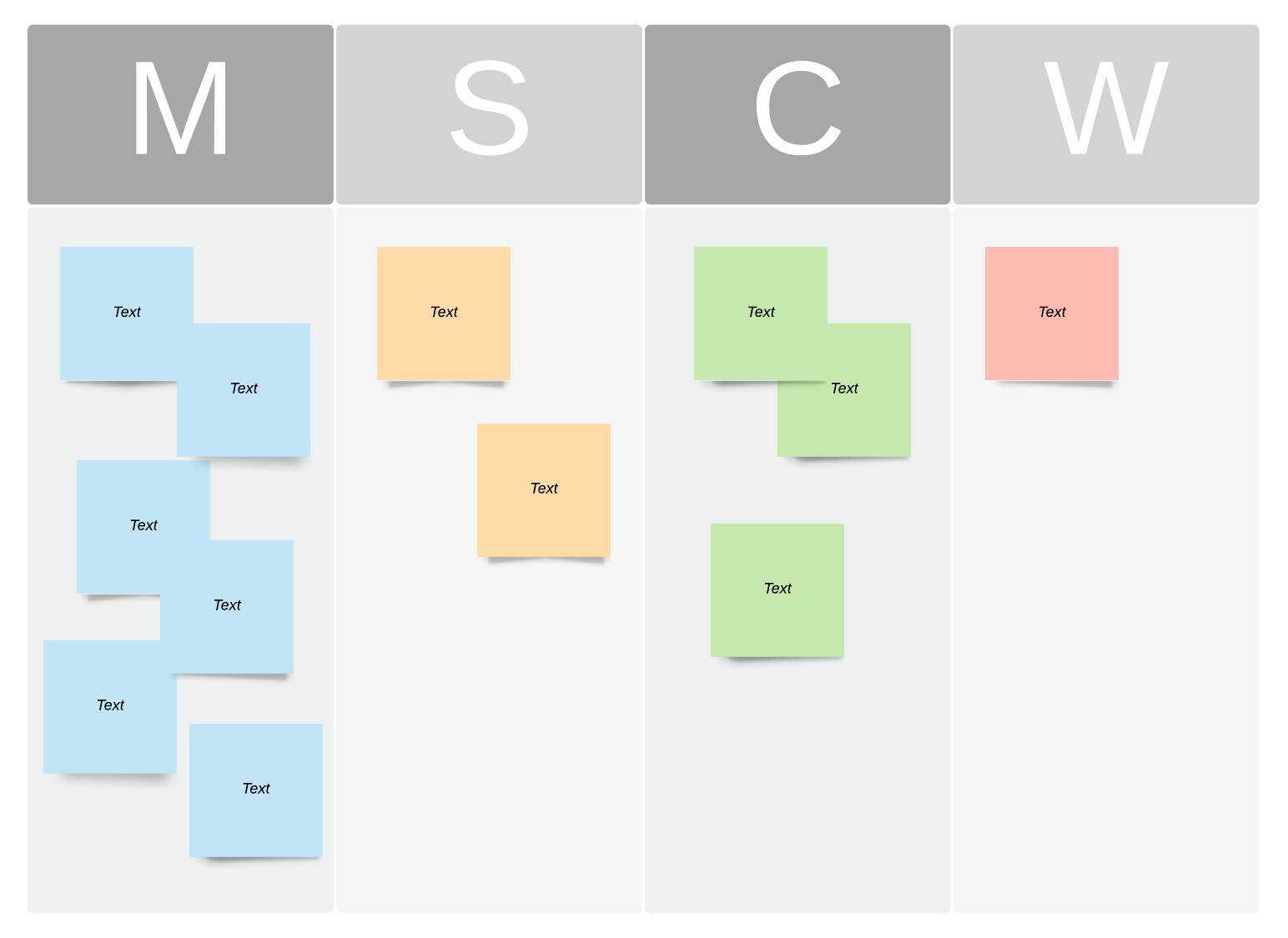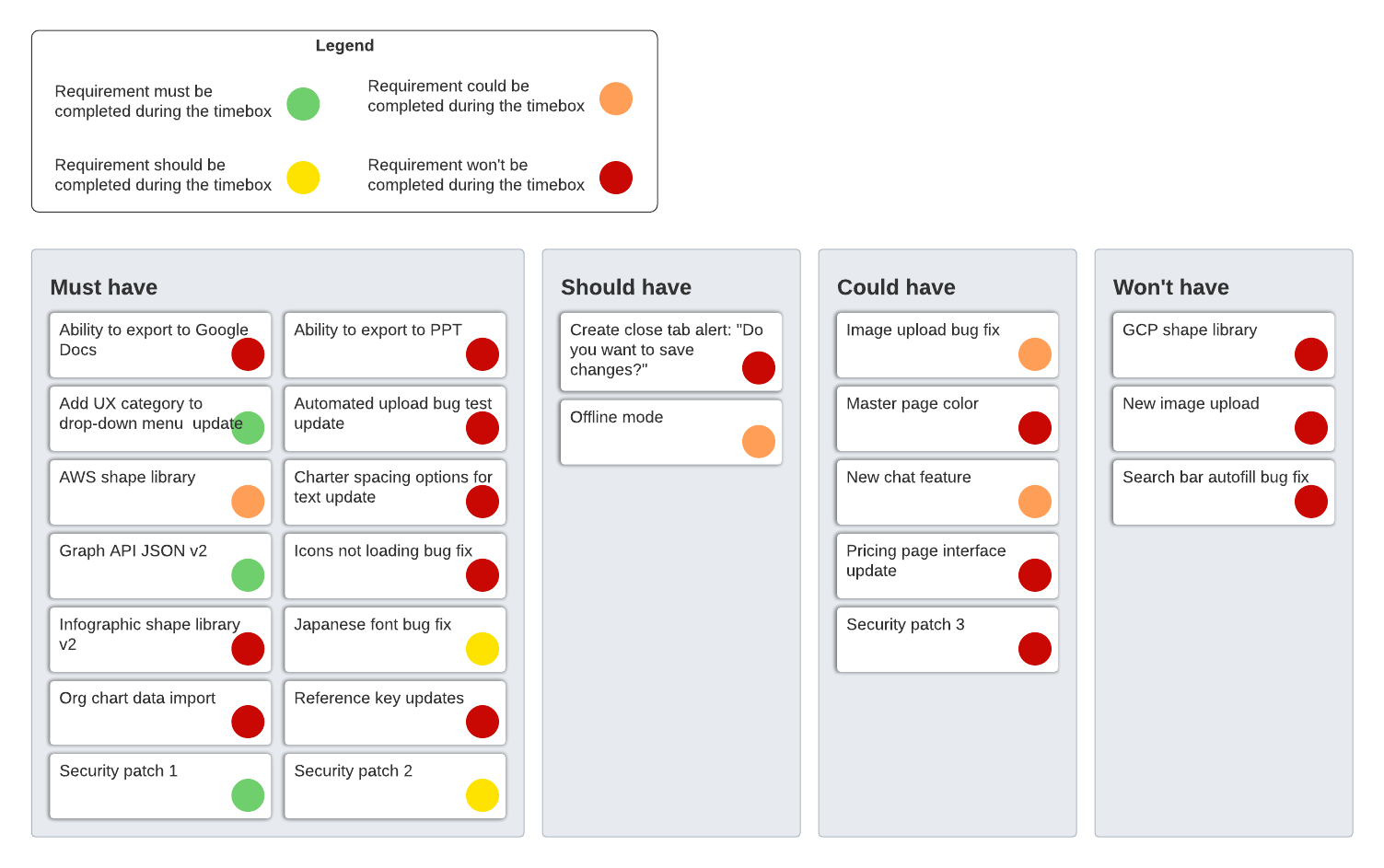
Introduction to MoSCoW prioritization
Reading time: about 6 min
When working on a new product or initiative, it can be hard to know where to start and how to prioritize the tasks ahead. This can be even more challenging when you bring multiple people together to weigh in. While it can take some time and team wrangling upfront, setting those priorities from the start establishes a strong foundation for your project going forward.
Effectively prioritizing project tasks from the start not only streamlines project communication but can help prevent costly delays and miscommunication down the road.
So how can you all align on what is most important and when things need to get done? That’s where MoSCoW prioritization comes in.
What is the MoSCoW method?
MoSCoW analysis was invented by Dai Clegg of Oracle UK consulting, who developed the technique to determine prioritization within projects that had severe time constraints.
This is an especially important technique to use in Agile methodology, which places the most value on items that carry the highest business value. The software features that you identify to be more valuable have the highest probability of being developed and implemented.
What are the requirements for MoSCoW prioritization?
The MoSCoW prioritization method has a straightforward set of requirements used to determine the importance of initiatives. The MoSCoW requirements help teams take a strategic, orderly approach to prioritization. This system cuts down on wasted time, arguments, and misdirection. It also omits as much bias as possible from the process so that everyone involved can take an objective view of the requirements at hand.
The MoSCoW requirements for prioritization fit into the four following categories.
Must have
These initiatives or features are absolutely critical to the project. Without them, the delivery will be a failure.
Should have
These aspects of the project are also critical, but may not be as time-sensitive as the “must have” bucket.
Could have
These features are nice to have and would make a great addition to the project, but are not critical. If there’s time, consider adding these in.
Won’t have
These features really aren’t worth the investment of time, energy, or budget. They could be considered at a later time, but aren’t beneficial at this point.
How to run a MoSCoW analysis
Now that you know the basics of MoSCoW prioritization, it’s time to try your hand at the MoSCoW technique with your own team using the following steps.
1. Identify and gather your key stakeholders
Imagine how messy things would get if everyone in your organization had a say in every aspect of a project. That’s why the first step of the MoSCoW prioritization method is to identify and gather both key stakeholders and the team who is directly responsible for developing the project at hand. You may wish to have representatives from teams across the organization or keep it lean.
2. Determine arbitration
Disagreements on prioritization may arise. It’s important to determine how to settle disputes before MoSCoW prioritization begins.
You may choose to have participants vote or determine the business value of each feature or initiative and then proceed with the feature with the highest value.
3. Divide resources
Obviously, the majority of resources should be devoted to the most critical initiative. But how the resources are divided should be up to your team.
Deciding the number of resources allocated to each category can help determine which “bucket” each initiative should go in. The “will not have” category will obviously not have any resources allocated to it. It’s up to your team and other key stakeholders to determine how the budget will be divided among the three other buckets.
4. Solidify timeframe
The tighter the timeframe, the fewer initiatives can fit into the “must have” category. Identifying the timeframe ahead of time helps bring a bit of reality to the process. Refer to the team actually developing the product for the most realistic view of development.
5. List it out
If you have a list of features or initiatives listed in your backlog, this is the time to bring it out. Otherwise, you may need to refer to the scope of the project and list out the requirements for the project at hand.
Either way, it’s important to have a complete list of the initiatives you’ll be prioritizing so that the process is complete and organized. Such a list will give anyone across the organization access to your prioritization, encourage transparency, and keep a cloud-based copy available.

Develop a strong product backlog to keep track of features and initiatives you want to launch in the future.
See how to make one6. Start prioritizing
During the MoSCoW prioritization process, your team will need to ask questions that accompany each category to better determine where each initiative belongs. Go down the list and ask the following questions for each feature or initiative. It’s likely that the most friction will exist between the “should have” and “must have” buckets.
If there’s no consensus at first, continue going down the list to identify the categories for other features and then, at the end of the prioritization, determine the appropriate categories for the features that weren’t immediately obvious at the beginning.
Must have:
- What happens if we release the product without this initiative?
- Is there any simpler way to complete this?
- Will this product work without this feature?
Should have:
- How much value does this feature add to the project?
- Can this wait until the next release?
Could have:
- Is this necessary to the core function of the project?
- How much impact will this have on the project if left out?
Will not have:
- Does this have zero or little importance to the project at this time?
- Is there a chance this could have priority in the future?
Once the features and initiatives have been divided into these prioritization categories, your team will have a clear idea of where to focus their energy. Below are MoSCoW prioritization examples you can follow. Customize these MoSCoW templates for a visual way to examine and prioritize your initiatives.


How the MoSCoW method will help your team
Because we’re human, it’s easy to become partial to certain aspects of a project. The MoSCoW method helps keep partiality to a minimum.
Project managers can use it to gain an objective, orderly approach to prioritization, which is especially important because every release in the agile method of development has a very specific timeframe and budget. Plus, wrangling the desires of stakeholders from various departments across the organization is difficult: You’ll want to address everyone’s wants while also conforming to very real-time constraints.
MoSCoW prioritization omits the majority of bias and allows team members and stakeholders with disparate desires to come together as a united front.
It also allows those working directly on the project to have a clear understanding of why they’re working on certain features or initiatives during the next release: With a MoSCow chart, they can have a visual list of why what they’re working on is so important. If certain features from the “must have” category are fully finished within the timeframe, there’s also no question about what the team should be doing next—that’s already been identified in the “should have” category.
MoSCoW method keeps the arguments to a minimum and helps develop products that deliver the highest business value faster.

Explore other ways to prioritize features (and other important decisions).
Learn moreAbout Lucidchart
Lucidchart, a cloud-based intelligent diagramming application, is a core component of Lucid Software's Visual Collaboration Suite. This intuitive, cloud-based solution empowers teams to collaborate in real-time to build flowcharts, mockups, UML diagrams, customer journey maps, and more. Lucidchart propels teams forward to build the future faster. Lucid is proud to serve top businesses around the world, including customers such as Google, GE, and NBC Universal, and 99% of the Fortune 500. Lucid partners with industry leaders, including Google, Atlassian, and Microsoft. Since its founding, Lucid has received numerous awards for its products, business, and workplace culture. For more information, visit lucidchart.com.
Related articles
Why you need a business analyst on your product development team
In this article, we go over why a business analyst (BA) should be an essential member of any product or software development team. Learn how a good BA can help you harness and tame your company data to better connect with your customers.
Get your priorities straight: How the priority matrix can help you focus on what matters most
A priority matrix is an important tool to help you weigh different factors and determine which tasks and projects to complete first. Learn why a priority matrix works and how to implement it in your business.
Matrix diagrams: What they are and how to use them
Matrix diagrams help project managers visualize and evaluate complex relationships so they can make better decisions and keep projects on track. Learn how to create your own (includes free matrix chart templates)!
A deep dive into the product management process
We'll explore product management so you can prioritize features, meet customer needs, and boost your chances of success.
